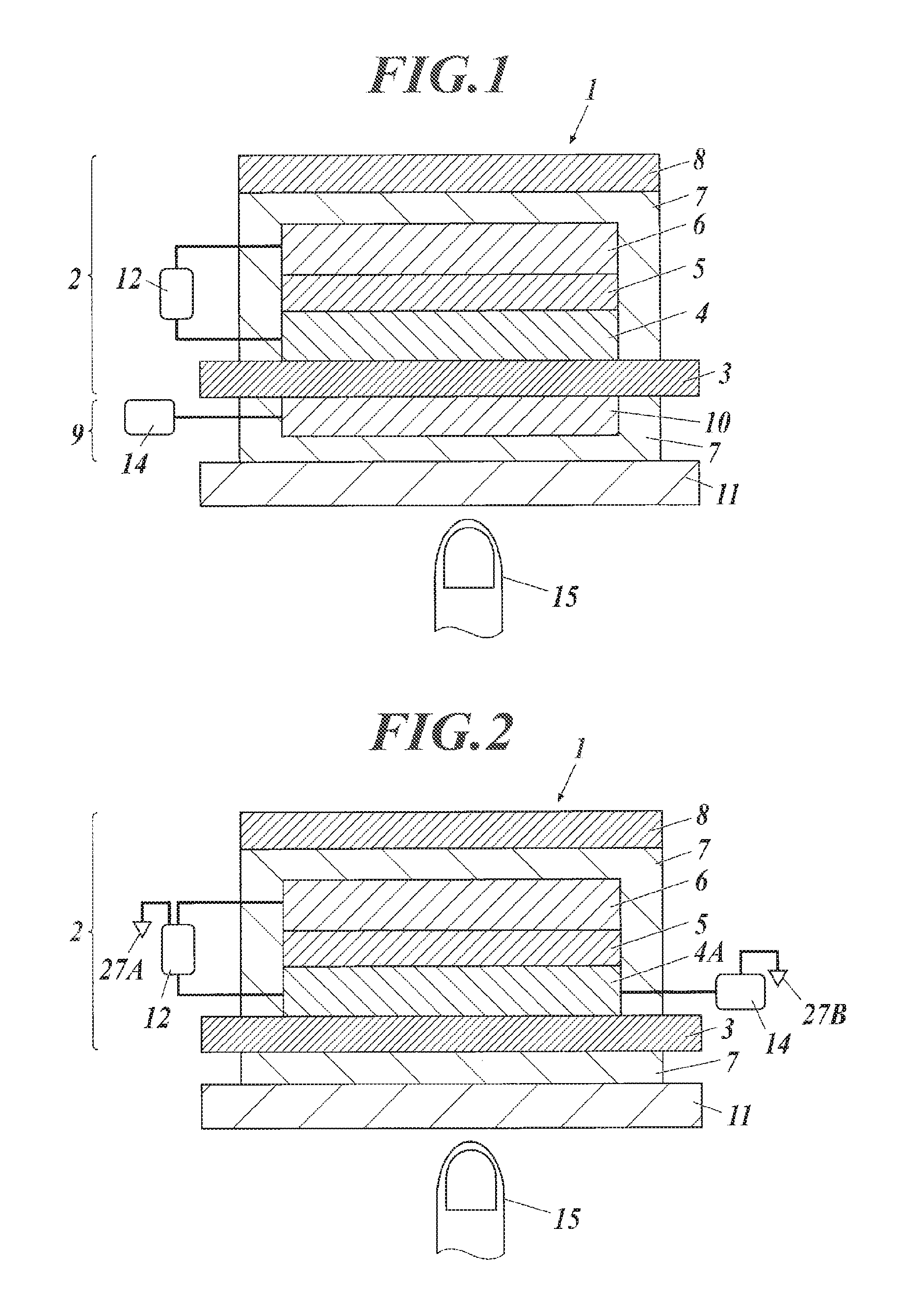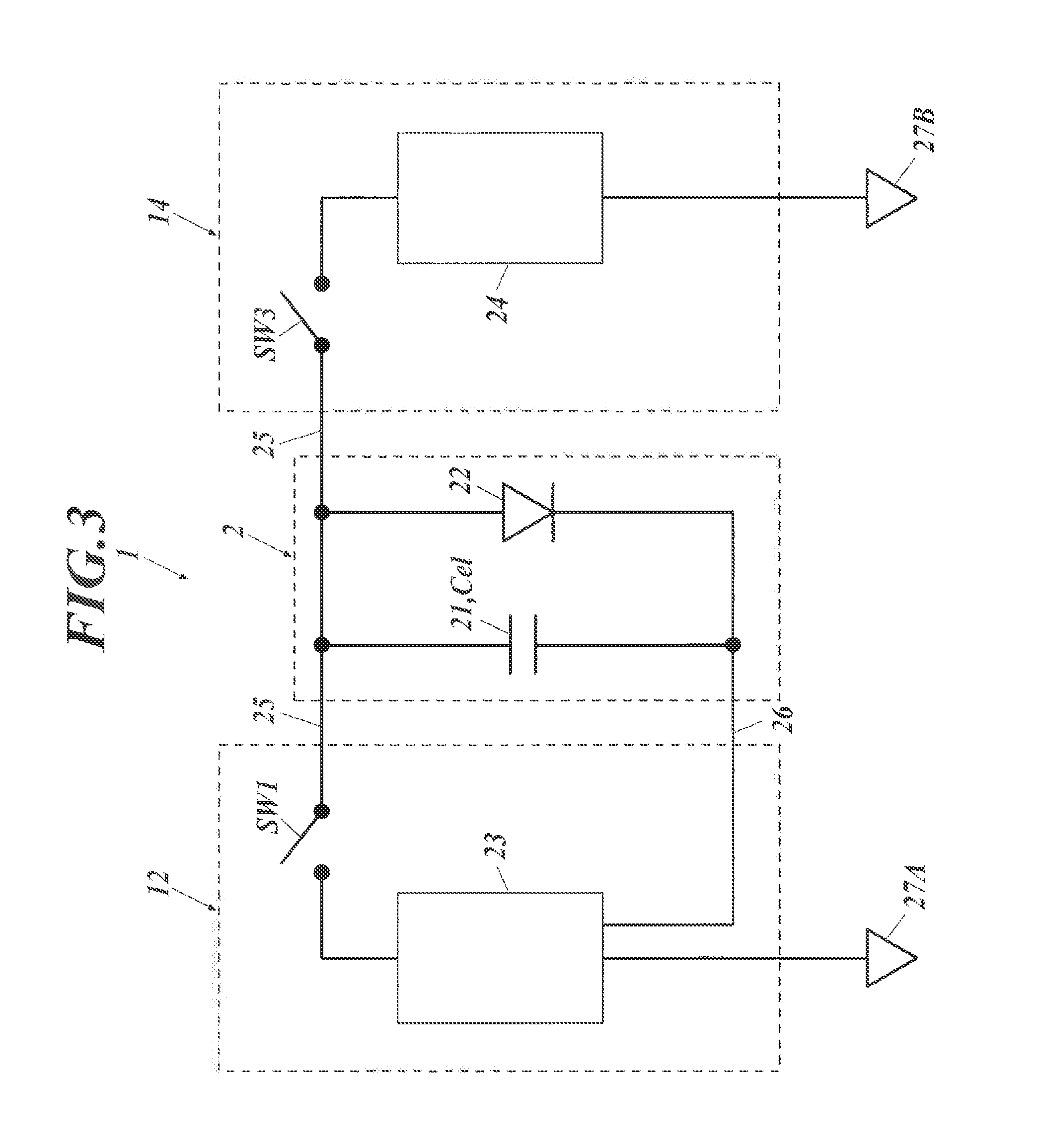Organic electroluminescence module, smart device, and illumination device
- Summary
- Abstract
- Description
- Claims
- Application Information
AI Technical Summary
Benefits of technology
Problems solved by technology
Method used
Image
Examples
embodiment 1
[0086]FIG. 3 illustrates a driving circuit for driving an organic EL module according to Embodiment 1.
[0087]In FIG. 3 illustrating a driving circuit for driving the organic EL module (1), the organic EL panel (2), which is illustrated on the middle of the drawing, includes an anode lead (25) connected to the anode (4A) (not shown) and a cathode lead (26) connected to the cathode (6) (not shown). An organic EL device (22) in the form of a diode and an interelectrode capacitor Cel (21) are connected between the anode lead (25) and the cathode lead (26).
[0088]In the light-emitting device driving circuit unit (12), which is illustrated on the left of the drawing, the anode lead (25) extending from the anode (4A) (not shown) is connected to a light-emitting device driving circuit section (23) via a first switch (SW1), and the cathode lead (26) extending from the cathode (6) (not shown) is connected to the light-emitting device driving circuit section (23). The light-emitting device drivi...
embodiment 2
[0114]FIG. 9 is a driving circuit diagram of an organic EL module according to Embodiment 2 of the present invention.
[0115]The organic EL module (1) illustrated in FIG. 9 has the same drive circuit as that illustrated above in FIG. 3, except that a fourth switch (SW4) is provided between the anode lead (25) and the cathode lead (26) for short circuit.
[0116]The light-emitting device driving circuit section (23) may include the first switch (SW1) therein. The touch sensing circuit section (24) may include the third switch (SW3) therein.
[0117]FIG. 10 is a timing chart (pattern 3) illustrating an exemplary emission term and sensing term in Embodiment 2.
[0118]In contrast to the timing chart illustrated in FIG. 5, the first switch (SW1) in the timing chart illustrated in FIG. 10 including the fourth switch (SW4) is turned on throughout the emission term (LT) to activate the OLED, and then the first switch (SW1) is turned off while the third and fourth switches (SW3 and SW4) are being turn...
embodiment 3
[0123]FIG. 13 is a driving circuit diagram of an organic EL module according to Embodiment 3.
[0124]With reference to FIG. 13, the light-emitting device driving circuit unit (12) does not have the first switch (SW1). In this module, the organic electroluminescent panel continuously emits light, and the touch sensing term periodically occurs under the control of the touch sensing circuit section.
[0125]With reference to FIG. 13, the light-emitting device driving circuit unit (12) has no switch, and thus the circuit is always closed (“ON” state), resulting in continuous emission of light from the organic EL device (22). The light-emitting device driving circuit section (23) is connected to the independent ground (27A).
[0126]In contrast, in the touch sensing circuit unit (14) illustrated at the right side, the anode lead (25) extracted from the anode functioning as a touch sensing electrode is connected to the touch sensing circuit section (24) via the third switch (SW3). This touch sens...
PUM
 Login to View More
Login to View More Abstract
Description
Claims
Application Information
 Login to View More
Login to View More - R&D Engineer
- R&D Manager
- IP Professional
- Industry Leading Data Capabilities
- Powerful AI technology
- Patent DNA Extraction
Browse by: Latest US Patents, China's latest patents, Technical Efficacy Thesaurus, Application Domain, Technology Topic, Popular Technical Reports.
© 2024 PatSnap. All rights reserved.Legal|Privacy policy|Modern Slavery Act Transparency Statement|Sitemap|About US| Contact US: help@patsnap.com










